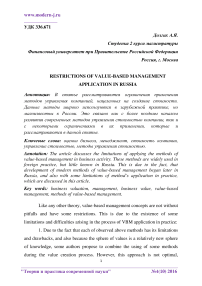Restrictions of value-based management application in Russia
Автор: Dolgikh A.Ya.
Журнал: Теория и практика современной науки @modern-j
Рубрика: Основной раздел
Статья в выпуске: 4 (10), 2016 года.
Бесплатный доступ
The article discusses the limitations of applying the methods of value-based management in business activity. These methods are widely used in foreign practice, but little known in Russia. This is due to the fact, that development of modern methods of value-based management began later in Russia, and also with some limitations of method’s application in practice, which are discussed in this article.
Management, business value, value-based management, methods of value-based management, business valuation
Короткий адрес: https://sciup.org/140289322
IDR: 140289322
Текст научной статьи Restrictions of value-based management application in Russia
Like any other theory, value-based management concepts are not without pitfalls and have some restrictions. This is due to the existence of some limitations and difficulties arising in the process of VBM application in practice:
-
1. Due to the fact that each of observed above methods has its limitations and drawbacks, and also because the sphere of values is a relatively new sphere of knowledge, some authors propose to combine the using of some methods during the value creation process. However, this approach is not optimal, 1
-
2. Financial model of company analysis suggests that in order to assess the situation it is necessary to consider participants motives. The traditional approach separates out the relationship of agent and business owners. The divergence of interests between the agent and the owner may be based, for example, on the conflict of the horizons: management, as a rule, look at a shortterm horizon, but owner needs a long-term one. Management of the company may be interested in the growth of scales, which gives the rise of personal power. The owner needs not only a growth of scales but also a growth of business value.
because the effectiveness of VBM methods can be achieved when all significant management decisions are used for common goal, which implies the existence of a single criterion. Therefore, in each case, the management of the company should select the appropriate value indicator (EVA, MVA, SVA, CFROI, CVA) according to efficiency, benefits and costs associated with obtaining the information, which is necessary for indicator calculation1.
The concept of value management as management innovation focused on the long-term interests of the company owners and takes into account the "agent owner" conflict. Meanwhile, in modern society it is necessary to achieve the maximization of the welfare of all stakeholders and not just business owners2. Thus, the question arises: “Whether this management innovation is not contrary to interests of other interested parties?
There are different opinions about this. According to Ivashkovskaya I.V. all of them can be divided into three groups3:
-
- the first (a negative radical) - rejects the possibility that there is no conflict between the interests of owners and other interested parties in the implementation of the VBM methods;
-
- the second (positive radical) - supports the argument of the followers of the contractual theory of the firm and substantiates the advantage of the interests of the shareholders because they bear more risks than the other participants;
-
- the third (compromise) - involves a constructive integration of approach in the concept of value management of the company from the position of interested parties.
-
3. The value based management methods raise the problem of further assessment of capital. It is vital to include not only debt and equity capital, but also other forms of capital such as intellectual capital (human, customer, organizational).4
In addition to observed system problems and limitations of the VBM concepts, there are also some difficulties of its practical implementation in the company, related mainly with:
-
- a necessity of change the overall corporate culture;
-
- a significant waste of time and resources for successful implementation;
-
- a necessity and difficulty of choosing control factors;
-
- a requirement of non-stop support from shareholders and managers.
Moreover, the implementation of VBM is very complicated process, because it involves a radical breaking of established corporate culture. According to Western statistics, the implementation of the VBM has a limited effect in half cases. It means the implementation does not justify all expectations. Here are some of the reasons that lead to failure:
-
4 Ivashkovskaya I. V. Value-based Management: challenges for Russian management // Russian management journal, №4, 2004. pp. 113–132.
-
• Company’s management underestimates the amounts of time and resources needed to implement VBM,
-
• Company’s management provides insufficient support for the application of VBM;
-
• Complicated or intricate methods of valuation are used;
-
• The wrong criteria of cost valuation were chosen.
As for Russian companies, there is a widespread opinion that companies operating in the post-Soviet market are not ready for the full implementation of VBM concept for some reasons:
-
- insufficiently developed stock market;
-
- the closed nature of the business entities;
-
- unpredictability of many factors, such as unexpected changes in legislative field, or prejudice of government authorities against companies for political reasons5.
Список литературы Restrictions of value-based management application in Russia
- Edvinsson, L. and Malone, M.S. Intellectual Capital: Realizing your Company’s True Value by Finding Its Hidden Brainpower, Harper Business, New York, New York, 1997.
- Sveiby, K.E. (2013) The New Organizational Wealth: Managing and Measuring Knowledge Based Assets, Berrett Koehler, San Francisco, CA
- Ivashkovskaya I. V. Value-based Management: challenges for Russian management // Russian management journal, №4, 2004. pp. 113-132.
- Kaledonsky D., Value-based management, “General Director” magazin, №5, 2013.


